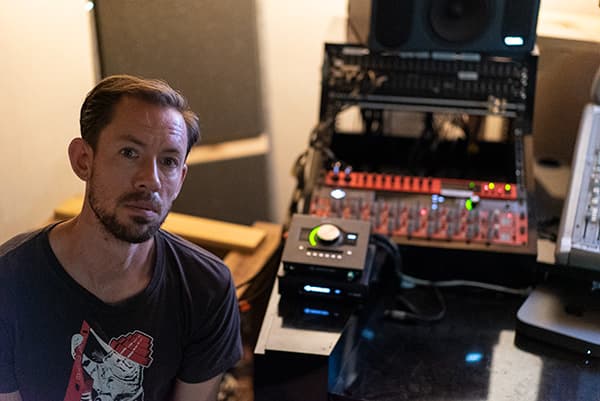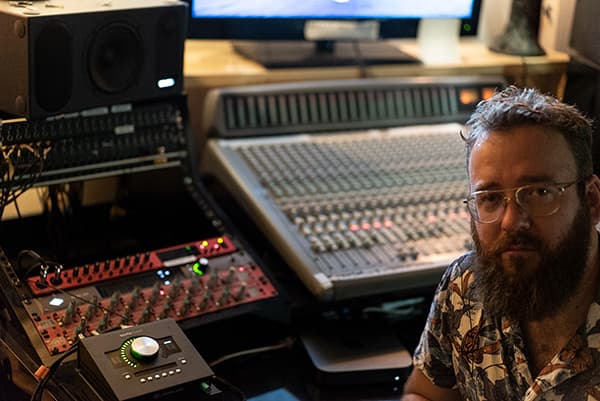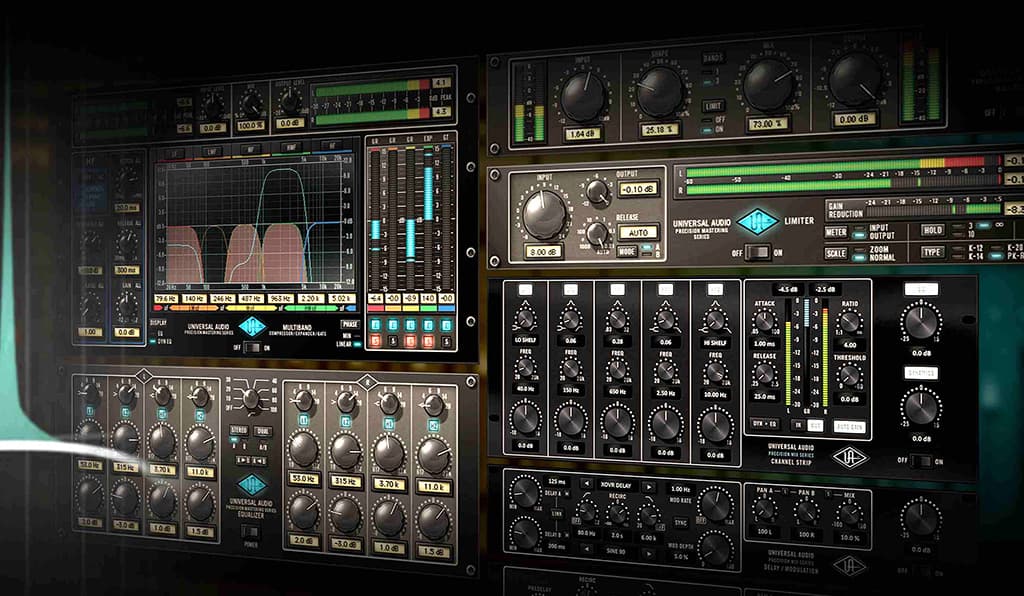
Exploring The Space: In The Studio With Hiatus Kaiyote
Hiatus Kaiyote’s first album was recorded on a digi002 in a share house. Then ‘Choose Your Weapon’ created worldwide mayhem like some psycho Shaolin assassination squad. Now five years on they’re about to unleash their third long player.
“There’s one thing that trips me up sometimes. I’ll be driving around listening to the radio and I’ll hear some really shiny pop song. I’m thinking, ‘I fucking hate how clean this is right now’! I mean, it could be the world’s most beautiful grand piano recorded in the world’s most beautiful room with million dollar microphones but it ends up sounding so good that it could just as easily be a sampled MIDI piano played in someone’s bedroom. It’s so clean that it’s impossible to tell. Me? I’d put it through a Space Echo, and use a mono tape version full of weird little ‘fuck-out’ tape aberrations. That interests me way more.” — Bender.
Hiatus Kaiyote want to take you places with their music. Their music isn’t so much about faithfully documenting a song or musical ideas, it’s about building a virtual time and place for your ears.
Which is why all four of the band members — Naomi ‘Nai Palm’ Saalfield (vocals), Paul Bender (bass), Simon Mavin (keys) and Perrin Moss (drums) — are so keen on space; creating the right conditions for cool ideas.
So I shouldn’t have been surprised to find Bender in a cave when I Skyped him. Actually, it’s a wine cellar, but hewn out of solid rock under his folks’ house in Tasmania by a South African industrialist. “It sounds so cool that I’m recording down here.” Perhaps not a grand piano, but still. He acknowledges that the booze-heavy echo chamber might be a killer recording space but sub optimal for video conferencing, and he shuffles the milk crate a little closer to his laptop.
The band’s outrageous success is so based on an apparent, gonzo, ‘whack this into that and see what happens’ studio work ethic that you get the feeling that everyone is wary of recording their new album in a traditional way… you know, in a recording studio, with an engineer and a producer… that sort of thing.
It’s not to say they’re illiterate in the ways of studio science, far from it, but they’re desperate to maintain a wide-eyed, self-conscious naivete… all in service of the vibe.
Sure, they have had technical assistance — Nick Harrera most recently has been helping them with tracking, and they spent a week here and there at Rockinghorse Studios and Park Orchards Recording Studio — but it’s more about keeping momentum in the session than it is to have another independent set of ears or a taste guru.
Instead they channel the energy of their early days — when they were all piled into a share house in Melbourne’s gritty old northern suburbs — jamming and creating great music by chasing a vibe.
“We produced that first record ourselves, because we could,” recalls Simon “We were all living in a house together. We had a real shitty setup — a bedroom studio of sorts; a ghetto shopfront we converted into a control room-slash-rehearsal room. We had a digi002 and were just having a crack. Bender had done a bit, and Perrin had been producing his own music for a few years previous to that. And it just worked.”

SELF SERVICE
It’s an approach that has served Hiatus Kaiyote well. And it’s the reason why the forthcoming album (‘Mood Valiant’) was, once again, mixed by Perrin and Bender and not some hotshot in L.A. — the inference: don’t mess too much with the formula or else you might end up sounding like any other jazz funk combo.
“No one in the band pretends to be a super-pro engineer. No one is banging out a couple of mixes a day. We will be working on this shit for months,” explains Bender. “We’ve often considered getting another engineer involved so we don’t get bogged down and to bring a specialist mix engineer’s bag of tricks to get the mixes to jump out of the speakers.”
Spoiler alert: they haven’t/didn’t. And the new album has been five years in the making. That’s a long time (I’m sure there’s an unwelcome ‘hiatus’ joke to insert here, but I won’t). Bender again:
“Trying to actually finish the record? It’s been fucked basically. Everyone’s so invested in everything, and we’ve all been hearing it for so long that you jump at shadows. It can do your head in.
“In the end, your cold lifeless body is just dragged over the finishing line behind the truck. You don’t have anything left.”
It reminds me of the maxim that ‘art is never finished, only abandoned’. And it makes you question the DIY work ethic, not because of the results but because of everyone’s mental health.
Bender: “I think it worked out pretty good. But I’m not going to listen to the record again for a very long time. When I do, hopefully it’ll put a smile on my face and it won’t be a case of ‘Fuck! Why didn’t I pull a little 10k out of that drum track?!’.
WILEY KAIYOTE
It all comes down to control over your own destiny. Gone are the days of million-dollar advances, studio lockouts and record labels pulling all the strings but anytime a new artist steps into a studio there’s a potential for the vision to be diluted or diverted by someone who ‘knows better’.
Simon: “We recorded ‘Tawk Tomahawk’ with a digi002 but when you look back on 2010, it was a crazy time because it was on the cusp of when you could realistically have really good shit to record with at home. You could do it pretty cheaply and get away with it.
“I think the biggest hurdle for artists when you go to a big studio is the way that certain engineers can push the project or sculpt it without you even realising it.
“And that, I think, is the reason Hiatus found its success — by breaking the rules. We had Nai singing a couple of metres away from a Rode NT2A with distortion cranked and the speakers on in the room. That probably wouldn’t happen in a recording studio because the engineer just wouldn’t allow it.
“It’s not easy for new artists to have the confidence to be able to do that in the studio and be comfortable about voicing their opinion — they’ve spent a lifetime working on their instrument or songwriting, and rarely have studio experience. But we managed to pull that off in the beginning. It’s something we do really well, I think.”
So you can see why Hiatus is more unwilling than most to relinquish control. They’ve bottled something special and everyone’s a little wary about it being bespoiled, even with the best intentions in world by the best engineers in the world.
People get rid of shit that they have no idea about and Simon’s is always there to snatch it up

BOTTLE IT
What have they bottled? When pressed, Bender finds the words to describe the band’s recording aesthetic. Talking about ‘a sound’ is a bit like dancing to architecture, but Bender pretty much nails it:
“For me, recording is about transporting my mind. It’s like you’re opening up some dusty old story book and travelling to some other time or place… like it’s a memory.
“Which is why there are always elements of something futuristic and some sort of nostalgia in what we do. There will be elements that are super hi-fidelity along with dirty elements.”
If one item of studio equipment could embody what Hiatus Kaiyote is all about, it might well be the Roland Space Echo tape delay device from the ’70s. It comes up in all three conversations I had with Perrin, Simon and Bender. There’s a ‘deus ex machina’ fascination. I’ll let Bender explain: “We’ve got a few Space Echoes now, and I think it is one of the most excellent pieces of equipment ever. The Space Echo is, essentially, a tape machine. You’re replacing the original signal with a tape version; a version that is a bit fucked. And every unit we’ve owned is a bit different — they have their own weird idiosyncrasies and defects. It means that you get unexpected wobbles and skips… and we are looking for those aberrations.”
HAPPY ACCIDENTS
And that goes a long way to describe Hiatus Kaiyote’s work methods: it’s about putting four gun musicians into a room and allowing the space, time and circumstances for happy accidents to occur. Not at the expense of an extremely competent recording but in addition to it.
Bender: “You want a full spectrum. You still want a great-sounding recording, only you’ve taken a normal-sounding instrument and done something to it to really give it some vibe and some real character. That’s a big part of every Hiatus recording: deciding what you make sound really crisp and what things you really fuck with.”
Engineer, Nick Harrera, was singing from the same song sheet. Nick would be plumbing signal into a bunch of unexpected places to maintain the band’s interest. Rockinghorse Studios in Bryon Bay has repurposed an old concrete water tank into an echo chamber. Nick set up the mics and a loudspeaker in the tank then mult’ed signal to an obligatory Space Echo along with several other destinations. In other words, he was creating the conditions for some Hiatus magic. “Five different things were happening at once,” recalls Bender. “It just turned into this crazy stereo image that’s super weird and unique and compelling. Like, fuck! That’s cool. That’s really, really cool.”


Simon Mavin (top) and Paul Bender in the studio.
NEW ALBUM: LANDING PARTY
About that new album, ‘Mood Valiant’. We can’t talk about it — not yet (at least, not when this story was published). It’s as-yet-unreleased; biding its time, circling the runway, waiting for the right covid-normal conditions to land.
But we can talk some more about how Hiatus Kaiyote go about their work.
The whole band pitches in on the creative vision, and are all record producers in their own right, but it’s the fellas that stick their heads into technology the most.
As mentioned, Perrin and Bender take care of the mixing. They divvy up the tracks; mix in the box with Pro Tools and Universal Audio powered plug-ins.
Perrin, Simon and Bender each have their own studios. Most of the gear has been prospected by Simon on Gumtree and Marketplace. Simon also has an extensive synth collection, which you can read about on a related post.
Perrin and Bender both combine an Apollo Twin desktop unit with an Apollo X16 in their racks. Simon’s setup uses an Apollo 8P. He’s also got himself a Universal Audio 4710D four-channel preamp/compressor which he says perfectly tag teams with the Apollo Twin via its ADAT optical inputs. “That setup gives you inserts on the 4710D’s four channels; the four line ins for the Twin’s other four channels; and you’ve got Hi-Z on every one of the pres. It’s just a brilliant pairing with minimal cables thanks to ADAT lightpipe. It’s great.”
recording is about transporting my mind. It’s like you’re opening up some dusty old story book and travelling to some other time or place… like it’s a memory



UAD NIRVANA
Perrin, Simon and Bender all confess their love for the UAD platform, often for different reasons. The Hiatus story is about a relationship with recording spaces, the sound of a room, the air between a source and a mic and how all that weaves a web to create a time and place for listeners to immerse themselves in. But once the audio is in the box, each of the boys are throwing the entire UA kitchen sink at the production.
Simon: “It’s ridiculous actually. It’s absurd that we can pull up whatever plug-in we want on any channel and everything is ridiculously good.
“We’ve been using UAD plugins for years and, even now, every time you pull something up, you momentarily reflect on just how ridiculous the position you are in — if you think about it, it’s insane.
“I was only just messing around with another production and pulled up the Valley People Dyna-Mite compressor for some drums tracks. And it’s just so good. My mate has recently bought a pair of hardware units. In comparison, the UAD version sounds bang on.
“Other favourites? I always seem to gravitate toward the the API 560 graphic EQ. I love the sound of that on drums. It’s just got a great top end that works amazingly well on drums.
Then there’s the Eventide Harmonizer. Putting vocals through that, even without calling up a preset, puts them in a great space.
“Same goes for the Precision plugins. They’re awesome. The K-Stereo [Ambience Recovery] plugin is great. It really opens things up in a lovely way.”
Bender: “The Precision Multiband compressor is just amazing. I was using it loads before someone said to me, ‘have you tried putting the Gate function on that Precision Multiband?’. I’m like, ‘no?’. And I tried it and that’s fucking crazy! You can do some really weird shit… multiband gating? That’s wild. You can transform something like a drum mix to a whole other vibe.
“I love the Sonnox Oxford Envolution on drums as well. That one’s crazy. It’s like a Transient Designer on steroids. You can be really creative with that or it can be just really useful. You can have something that’s stabbing you in the ear — ‘actually I don’t want to hear that, I want to hear more of the room’ — it allows you to find that bigger space. Unlike the Transient Designer, there are more ways to fine tune the sound. You can be creative and it can help you to sit a sound in the mix way better.”
In the end your cold lifeless body is just dragged over the finish line behind the truck. You don’t have anything left
ECHOES OF ANOTHER SPACE
Hiatus Kaiyote is a poster child for the democratisation of studio technology. They demonstrate that the disciplines of musicianship, songwriting, audio engineering and production can be intimately intertwined and the results are likely to be more innovative, off the wall even, compared to when you keep all the record-making roles in silos. That said, the process may well kill you.
Now that the new album is out of their hands and serious touring is still a ways off, the boys can keep playing in their studio sandboxes. Bender’s new warehouse studio space represents a whole world of possibilities, even if it currently leaks sound like an acoustic sieve (“the neighbours are understanding”).
Bender: I’m just playing with physical space; playing in big spaces with lots of air and lots of options. Being able to mess around with that is really fun. Especially given where we’ve come from, doing the first recording in a share house in Northcote — five people living there and only one room to record. The new studio reminds of when me, Perrin and Simon first messed with a Space Echo in the share house studio — it was like we’d opened up a whole new world of possibilities. That’s how I feel now.”
















RESPONSES